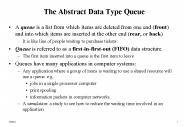Recognizing Data Types - PowerPoint PPT Presentation
1 / 17
Title:
Recognizing Data Types
Description:
Recognizing Data Types What Will I Learn? Define data type and explain why it is needed List and describe categories of data types Give examples of scalar, composite ... – PowerPoint PPT presentation
Number of Views:77
Avg rating:3.0/5.0
Title: Recognizing Data Types
1
Recognizing Data Types
2
What Will I Learn?
- Define data type and explain why it is needed
- List and describe categories of data types
- Give examples of scalar, composite, and large
object (LOB) data types
3
Why Learn It?
- Every constant, variable, and parameter has a
data type (or type), which specifies for what
type and size of data it can be used, plus how it
is stored. - PL/SQL provides a variety of predefined data
types. For instance, you can choose from integer,
floating point, character, Boolean, date,
collection, and LOB types. - This lesson introduces the basic types that are
used frequently in PL/SQL programs.
4
PL/SQL Data Types
- A data type specifies a storage format,
constraints, and a valid range of values. - PL/SQL supports five categories of data type
- Scalar Hold a single value
- Composite Contain internal elements that are
either scalar (record) or composite (record and
table) - Large object (LOB) Hold values, called locators,
that specify the location of large objects (such
as graphic images) that are stored out of line - Reference Hold values, called pointers, that
point to a storage location - Object A schema object with a name, attributes
and methods. An object data type is similar to
the class mechanism supported by C and Java.
5
Scalar Data Types
- Hold a single value
- Have no internal components
- Can be classified into four categories
- Character
- Number
- Date
- Boolean
6
Scalar Data Types Character (or String)
7
Scalar Data Types Number
8
Scalar Data Types Date
9
Scalar Data Types Date (continued)
10
Scalar Data Types Boolean
11
Composite Data Types
- A scalar type has no internal components. A
composite type has internal components that can
be manipulated individually. - Composite data types include the following
- TABLE
- RECORD
- NESTED TABLE
- VARRAY
- TABLE and RECORD data types are covered later in
this course
12
Composite Data Types
13
LOB Data Type
- Large objects (LOBs ) are meant to store a large
amount of data. - A database column can be of the LOB category.
- There are several categories of LOB data types
- character large object (CLOB)
- binary large object (BLOB)
- binary file (BFILE)
- national language character large object (NCLOB)
- LOB data types enable you to store blocks of
unstructured data up to 4 gigabytes in size. - LOB data types enable efficient, random,
piecewise access to the data and can be
attributes of an object type.
14
LOB Data Type
15
Terminology
- Key terms used in this lesson include
- Scalar
- Composite
- LOB
- Reference
- Object
- CLOB
- BLOB
- BFILE
- NCLOB
16
Summary
- In this lesson, you have learned how to
- Define data type and explain why it is needed
- List and describe categories of data types
- Give examples of scalar, composite, and large
object (LOB) data types
17
Try It/Solve It
- This practice covers the following topics
- Defining data type and explaining why it is
needed - Listing and describing categories of data types
- Giving examples of scalar, composite, and large
object (LOB) data types



















![Full Guide on Samsung Data Recovery [Updated] PowerPoint PPT Presentation](https://s3.amazonaws.com/images.powershow.com/9355974.th0.jpg?_=20191101043)











